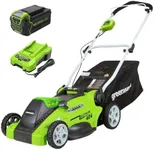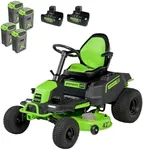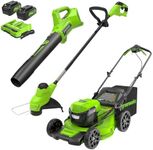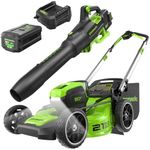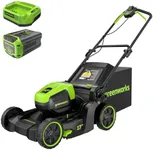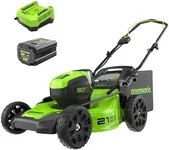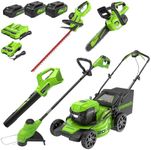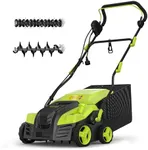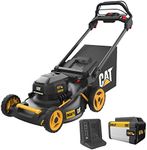Buying Guide for the Best Greenworks Lawn Mowers
Choosing the right lawn mower can make a significant difference in maintaining a beautiful and healthy lawn. When selecting a Greenworks lawn mower, it's important to consider various specifications to ensure you get the best fit for your needs. Here are some key specs to look at and how to navigate them.Power SourceThe power source of a lawn mower can be either electric (corded or cordless) or gas. Electric mowers are quieter, more environmentally friendly, and require less maintenance. Corded models offer unlimited run time but are limited by the length of the cord, making them suitable for smaller yards. Cordless models provide more mobility but have limited battery life, making them ideal for medium-sized yards. Gas mowers are powerful and can handle larger lawns but are noisier and require more maintenance. Choose based on the size of your lawn and your preference for convenience and environmental impact.
Cutting WidthThe cutting width refers to the width of the mower's blade and determines how much grass is cut in a single pass. A wider cutting width means fewer passes to mow the lawn, saving time. For small lawns, a cutting width of 14-16 inches is sufficient. Medium-sized lawns benefit from a width of 17-21 inches, while large lawns may require a width of 22 inches or more. Consider the size of your lawn and how much time you want to spend mowing when choosing the cutting width.
Battery LifeFor cordless electric mowers, battery life is crucial as it determines how long you can mow before needing to recharge. Battery life is usually measured in ampere-hours (Ah). A higher Ah rating means longer run time. For small lawns, a battery with 2-4 Ah may be sufficient. Medium-sized lawns may require 4-6 Ah, while large lawns might need 6 Ah or more. Assess the size of your lawn and how long it typically takes to mow to determine the appropriate battery life.
Cutting Height AdjustmentCutting height adjustment allows you to change the height at which the grass is cut. This is important for maintaining the health of your lawn, as different grass types and seasons require different cutting heights. Most mowers offer a range of height settings, typically from 1 to 4 inches. For versatility, choose a mower with multiple height settings that can be easily adjusted. Consider the type of grass you have and the seasonal changes in your area when selecting the cutting height range.
Grass Management OptionsGrass management options include mulching, bagging, and side discharge. Mulching mowers finely chop the grass clippings and return them to the lawn, providing nutrients. Bagging mowers collect the clippings in a bag for easy disposal, leaving a clean lawn. Side discharge mowers expel the clippings to the side, which can be useful for less frequent mowing. Some mowers offer multiple options, allowing you to switch between them. Choose based on your preference for lawn cleanliness and how you want to manage the grass clippings.
Weight and ManeuverabilityThe weight and maneuverability of a lawn mower affect how easy it is to push and navigate around your yard. Lighter mowers are easier to handle, especially in smaller yards with tight spaces. Heavier mowers may offer more stability and power but can be more challenging to maneuver. Self-propelled mowers can help reduce the effort needed to push the mower, making them a good choice for larger or hilly lawns. Consider your physical ability and the layout of your yard when choosing the weight and maneuverability of your mower.
